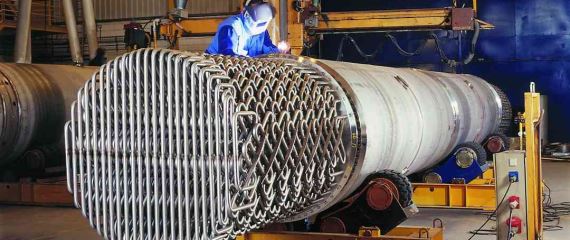News
30
July 2020
Effect of pH and temperature on crevice corrosion of nickel based alloys
 Nickel based alloys are used in a wide range of applications as corrosion resistant materials, heating element and also creep resistant materials. Other applications include construction materials. These alloys can create a security layer in some conditions to provide corrosion resistance. Although, they may be affected in environments comprising significant magnitudes of chloride or halide ions, particularly in the presence of oxidizing species. The presence of oxidizing species at high temperatures can corrode these alloys. The corrosion may occur in different forms such as localized corrosion, stress corrosion cracking and uniform corrosion. Crevice corrosion is severe than pitting. The mechanism of this type of attack is as following:
The performance of Hastelloy C276 and Inconel 625 is investigated. How does temperature impact passive current and critical pH of these alloys? It is found that critical pH for crevice corrosion of Inconel 625 is a function of temperature and chloride concentration, whilst the same connection is not found between these factors and critical pH. The critical pH of crevice solution for Inconel 625 lies in 1.7 and 0.0 based on service condition. Although, for Hastelloy C276, the pH for crevice corrosion could not be found. The outcomes show that Hastelloy C276 wire’s resistance to crevice corrosion is superior to Inconel 625 in same test conditions.
When corrosion progresses, the electrolyte in crevice is depleted in oxygen as it cannot be replaced adequately by diffusion. This condition creates a galvanic cell where the cathodic reaction causes oxygen reduction outside the crevice. The anodic reaction in the crevice results into metal oxidation. Movement of chloride in the crevice to balance the accumulated positive charges result from hydrolysis of metal chlorides.
During the incubation level of crevice corrosion, the beneath metal or alloy is secured by the developed passive layer. At this level, metal corrosion occurs slowly based on the properties of the passive layer. Once the layer is slightly damaged crevice corrosion occurs at a higher speed. At temperature range of 25oC to 100oC and pH 0, a transition is seen from active to passive form in Inconel 625 resulting in two current values, peak and passive currents. On the other hand, no transition occurs for Hastelloy C276. The effect of temperature is observed for both alloys.
Hastelloy C276 and Inconel 625 were tested in .5, 1 and 4 M NaCl. When temperature reaches 25oC, pH for Inconel 625 is 0 and Hastelloy C276 remains intact of breakdown at this pH. The critical pH value can be considered as a factor to the susceptibility of an alloy to crevice corrosion and hence can be used in categorizing alloys for their resistance to crevice corrosion. Peak and passive currents increase with an increase in chloride ion concentration and temperature. It was noticed alloys were active at higher pH values with increase in temperature. pH increases with increase in chloride ion concentration and temperature. Meanwhile Hastelloy C276 remains resistant to crevice corrosion and offers good performance.
Nickel based alloys are used in a wide range of applications as corrosion resistant materials, heating element and also creep resistant materials. Other applications include construction materials. These alloys can create a security layer in some conditions to provide corrosion resistance. Although, they may be affected in environments comprising significant magnitudes of chloride or halide ions, particularly in the presence of oxidizing species. The presence of oxidizing species at high temperatures can corrode these alloys. The corrosion may occur in different forms such as localized corrosion, stress corrosion cracking and uniform corrosion. Crevice corrosion is severe than pitting. The mechanism of this type of attack is as following:
The performance of Hastelloy C276 and Inconel 625 is investigated. How does temperature impact passive current and critical pH of these alloys? It is found that critical pH for crevice corrosion of Inconel 625 is a function of temperature and chloride concentration, whilst the same connection is not found between these factors and critical pH. The critical pH of crevice solution for Inconel 625 lies in 1.7 and 0.0 based on service condition. Although, for Hastelloy C276, the pH for crevice corrosion could not be found. The outcomes show that Hastelloy C276 wire’s resistance to crevice corrosion is superior to Inconel 625 in same test conditions.
When corrosion progresses, the electrolyte in crevice is depleted in oxygen as it cannot be replaced adequately by diffusion. This condition creates a galvanic cell where the cathodic reaction causes oxygen reduction outside the crevice. The anodic reaction in the crevice results into metal oxidation. Movement of chloride in the crevice to balance the accumulated positive charges result from hydrolysis of metal chlorides.
During the incubation level of crevice corrosion, the beneath metal or alloy is secured by the developed passive layer. At this level, metal corrosion occurs slowly based on the properties of the passive layer. Once the layer is slightly damaged crevice corrosion occurs at a higher speed. At temperature range of 25oC to 100oC and pH 0, a transition is seen from active to passive form in Inconel 625 resulting in two current values, peak and passive currents. On the other hand, no transition occurs for Hastelloy C276. The effect of temperature is observed for both alloys.
Hastelloy C276 and Inconel 625 were tested in .5, 1 and 4 M NaCl. When temperature reaches 25oC, pH for Inconel 625 is 0 and Hastelloy C276 remains intact of breakdown at this pH. The critical pH value can be considered as a factor to the susceptibility of an alloy to crevice corrosion and hence can be used in categorizing alloys for their resistance to crevice corrosion. Peak and passive currents increase with an increase in chloride ion concentration and temperature. It was noticed alloys were active at higher pH values with increase in temperature. pH increases with increase in chloride ion concentration and temperature. Meanwhile Hastelloy C276 remains resistant to crevice corrosion and offers good performance.

